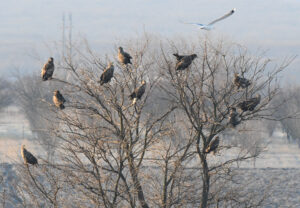Third International Scientific and Practical Conference “Eagles of the Palearctic: Study and Conservation”
Raptors Conservation. Suppl. 2. Proceedings of Conferences
Remote Tracking of White-Tailed Sea Eagles from Transbaikalia, Russia: Migration, Wintering, Summer Stay
Goroshko O.A. (Daursky State Nature Biosphere Reserve; Chita Institute of Nature Resources, Ecology and Cryology, Chita, Russia)
Zaitsev I.S. (Daursky State Nature Biosphere Reserve, Nizhny Tsasuchei, Russia)
Huashan D. (Hulun Lake National Nature Biosphere Reserve, Hailar, China)
Anisimov Yu.A. (Baikal State Nature Biosphere Reserve, Tankhoy, Russia)
Songtao L. (Hulun Lake National Nature Biosphere Reserve, Hailar, China)
Pyzhianov S.V. (Irkutsk State University, Irkutsk, Russia)
Contact:
Oleg Goroshko oleggoroshko@mail.ru
Ivan Zaitsev zaitsev-student@mail.ru
Dou Huashan douhuashan@163.com
Yuriy Anisimov janisimov@gmail.com
Liu Songtao 398861907@qq.com
Sergey Pyzhianov pyzh@list.ru
Recommended citation: Goroshko O.A., Zaitsev I.S., Huashan D., Anisimov Yu.A., Songtao L., Pyzhianov S.V. Remote Tracking of White-Tailed Sea Eagles from Transbaikalia, Russia: Migration, Wintering, Summer Stay. – Raptors Conservation. 2023. S2: 68–72. DOI: 10.19074/1814-8654-2023- 2-68-72 URL: http://rrrcn.ru/en/archives/34884
Remote tracking of the White-Tailed Sea Eagle (Haliaeetus albicilla) has not yet been carried out in Transbaikalia (Russia). Four juveniles from two nests (2+2) were tagged on 19/06/2020 in the Selenga River delta, Buryatia (about N 52.21; E 106.45) by GPS/GSM trackers. Tracker №149 was lost during migration on 05/12/2020 in the western Khangai, Mongolia; №158 was lost during the first wintering 03/01/2021 (most probable migration was unfinished); №156, №157 were lost during third wintering in February-March of 2023. In all cases the signal lost was due to transmitter failure. Data on two autumn migrations is incomplete due to poor tracker condition providing no signal for 3–15 days (№156 in 2022, №157 in 2021).
Fledging occurred on average on 21/07 (July 15–28); the first short flights within 1 kilometer from the nest on 12/08 (06– 21/08); first long flights over 10 km on 11/09 (02/09–02/10); last visit to the nest on 12/10 (06/09-13/11); start of fall migration on 27/10 (8/10–19/11), and its finish on 19/11 (27/10–28/12). The duration of fall migration varies from 14 to 19 days, but in one case №158 stayed at the stopover site for 25 days, therefore this migration lasted 56 days. During the first fall, №156 and 157 had 13 and 19 stops and spent there 72% and 68% of total migration time respectively; №158 spent 85% of the time at 19 stops.
The spring migration started on average on 16/03 (11/03–23/03) and finished on 06/04 (30/03–17/04); its duration varies from 10 to 35 days. During the spring migration in 2021 and 2022, №156 and 157 had an average of 14 stops (9–17) and spent there an average of 78% of time (6587%). The average speed of fall migration is 110.2 km per day (52–137), of spring migration is 148.7 km per day (63–221.4).
Usually, the flight paths in the fall and spring are approximately the same. The total flyway corridor is up to 1,000 km wide within the range from western Khangai mountains to the center of the Gobi Desert. The main flyway is about 300–450 km wide and passes through the Khangai, Mongolian Altai, and Nanshan mountains. The route in total is slightly curved in the western direction as birds try to avoid Gobi Desert. Usually, they cross comparatively narrow 450–500 km wide western margins of the Gobi. But eagles can also migrate using the shortest direct path, crossing about 650–800 km of central Gobi; they use this way only during autumn migration (5 autumn routes over eastern Gobi and 3 over central Gobi for №156–158). The total length of the routes (without local movement on the migratory stopover sites) varies from 2,333 km (straight path) to 2,934 km (westward curved path).
The wintering sites are located in the upper reaches of the Yellow River basin on the eastern fringes of the Tibetan Plateau, China. The №156 and №157 consistently returned to the same individual sites for three years: №157 on the Datun River (about N 37.3; E 101.8); №156 at two sites in 500–600 km southward of №157: on the Jiaomuzu River (N 32.01; E 102.02) and Baihe River (N 32.9; E 102.67) about 90 km apart from each other. The №158 was lost on the Yellow River (about N 34.4; E 101.12) after three days there. Additionally, one juvenile, ringed on the Selenga River delta on 18/06/2018 was registered on 24/01/2021 in the upper stream of the Yellow River (N 38.58; E 106.54). The area of the individual wintering range shrinks year by year because the birds explore the territory more in the first years, then they use optimal locations. The home range (more 90% of wintering time) of №157 were 83.5 km2 in 2020/2021, 63 km2 in 2021/2022, 31.8 km2 in 2022/2023; shrunk by 62% (24% between first and second winter, and 49% between second and third). Area of the first wintering site of №156 was 525.5 km2 in 2020/2021, and 174.3 km2 in 2021/2022 (shrunk by 66%); the second site was 175 km2 in 2020/2021, 153.7 km2 in 2021/2022 (shrunk by 12%); no exact data for third winter due to poor transmitter work.
The wintering sites on Jiaomuzu and Baihe Rivers are sparsely populated by humans, nearby territories are used as pastures for yaks. The site on Datun River is more densely populated, banks of the river are used as agricultural fields. In daytime the birds stay mainly on the rivers for feeding and they use forest areas or single trees on the river valleys for overnight stay and sometimes for daytime rest; White-Tailed Sea Eagles do not visit agricultural fields or rest on power lines.
In summer, eagles have always inhabited the Selenga River delta. In one case №157 flew to Ilga River on the western side of Baikal Lake in 2021. Similar to winter ranges, summer ranges were smaller in 2022 than in 2021: the №156 occupied 1,469.9 km2 в 2021 г. и 881,6 км2 in 2022 (shrunk by 40%); the №157 occupied 18,558.4 km2 in 2021, 1,844.1 km2 in 2022 (shrunk by 90%).

